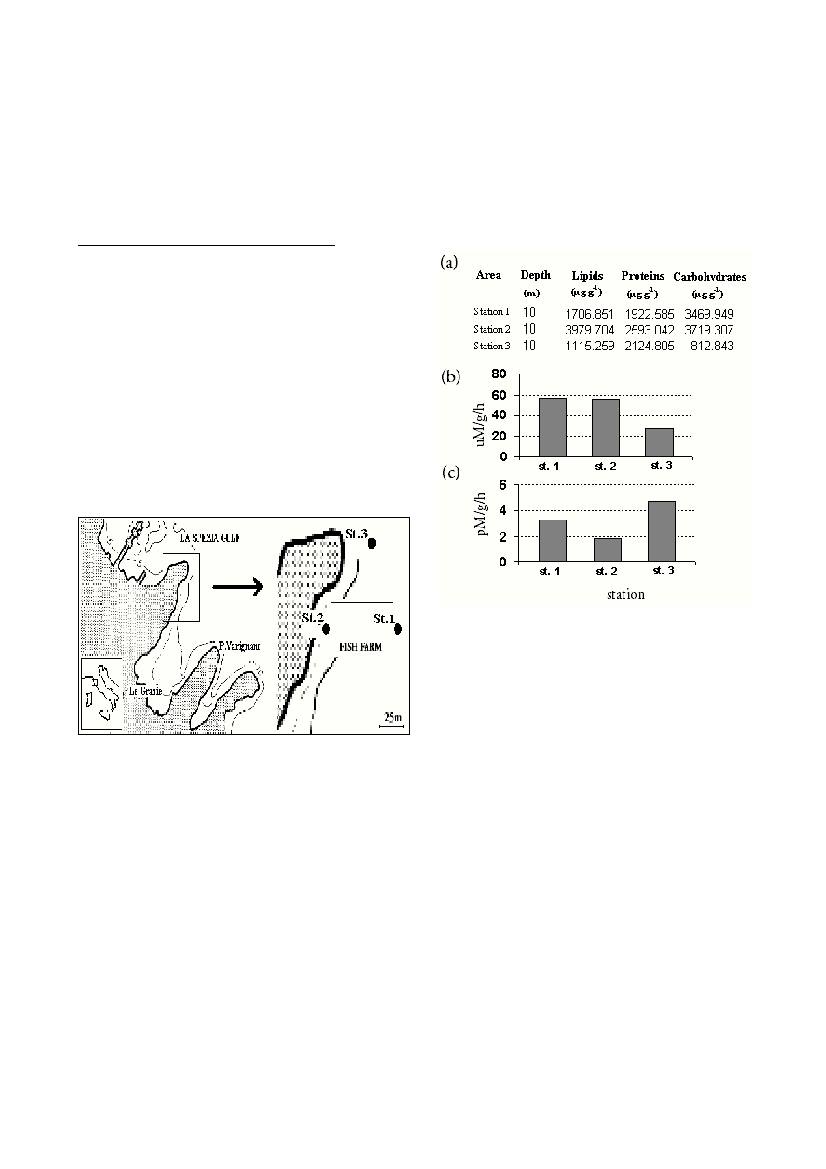Rapp. Comm. int. Mer Médit., 36,2001
216
Rapp. Comm. int. Mer Médit., 36,2001
The large diffusion of intensive fish-farm activities on the continental
shelf of the Mediterranean Sea is causing increasing concern for the strong
environmental impact. The most evident effects of the fish cages on bottom
sediments are the accumulation of organic matter (OM) and the progres-
sive transformation of the substrate into a ?occulent anoxic environment
(1). Previous studies have clearly demonstrated that disturbance induced
by increasing organic loads in coastal areas might determine changes in the
community structure and biodiversity of the benthic assemblages (2), and
in some extreme cases might even result in azoic sediments (2). However
little is known on the functioning and response of the benthic community
and in particular to those compartments more directly affected by OM
input such as bacteria (3).
We studied the impact of organic loads due to the biodeposition of a well
established fish farm in a coastal area of the Ligurian Sea (Gulf of La Spezia,
Western Mediterranean) in order to assess organic matter composition, bac-
terial response and functioning at a mature stage of organic enrichment.
Sediment chemistry and microbial parameters were investigated in June,
July, September and October 2000 at two stations located along a transect
crossing the farming area and directed from coast to the open sea (inshore
and offshore) while a third station was investigated at about 200m distance
and served as a control (Fig. 1).
Reducing conditions were recorded in the top sediment layer for
stations located under the fish cages (Eh<-50mV). The accumulation
of organic matter (in term of proteins, carbohydrates and lipids) were
significant (Fig. 2a) and higher in June and October; moreover the
highest OM concentrations were detected at the inshore station where
water exchange was scarcer. Lipids and carbohydrates highlighted the
most pronounced changes if compared to the control while proteins
were the more conservative; lipids in particular showed very high val-
ues (up to 4973.2 µg g
-1
) in relation to the feeding activity and could
be identified as important biomarkers of organic loads in fish farm sed-
iments.
Benthic bacteria appeared to be strictly related to organic enrich-
ment as their abundance were three fold higher (up to 344.38 108cells
g-1) in stations beneath the cages if compared to the control. The auto-
?uorescent cells (AFC) accounted for less than 1.5% of total bacterial
abundance (TBN). Furthermore the AFC to TBN ratio does not repre-
sent a useful tool in evaluating the impact of biodeposition displaying
similar values both in fish farm and control stations (3).
The dynamic of microbial community has been investigated by
means of functional parameters such as the Frequency of Dividing
Cells (FDC) and aminopeptidase enzymatic activity. Both FDC than
aminopeptidase displayed higher absolute values in sediment beneath
the cages; by contrast enzymatic activity per cell was lower (Fig 2b,c).
According to what was observed in other eutrophic systems such as
the Northern Adriatic Sea (4) we hypothesise that in conditions of
strong and continuous organic enrichment the bacterial degradation
rates may show a functional stress. This can be viewed as a valuable
environmental index to highlight the unbalance occurring between the
supply and exploitation of OM in eutrophic environments.
3. References
1. Holmer M., 1991. Impacts of aquaculture on surrounding sediments:
generation of organic-rich
sediments. In Aquaculture and the Environment. (N. Pauw and J. Joyc, ed.)
Aquaculture Society Special Publication, 16: 155-175.
2.Weston, D. P. (1990). Quantitative examination of macrobenthic community
changes along an organic enrichment gradient. Marine Ecology Progress.
Series, 61, 233-244.
3. La Rosa, T.; Mirto, S.; Mazzola, A.; Danovaro, R. (2000). Differential
responses of benthicmicrobes and meiofauna to fish-farm disturbance in
coastal sediments. Environmental Pollution, 0 :1-8.
4. Fabiano, M.; Misic, C.; Manini, E.; Danovaro, R.; Povero, P.; Chiatti, S.
(2001). Distribution and biochemical composition of suspended and
sedimentary organic matter in the Northern Adriatic. In: Structure and
processes in the Mediterranean ecosystems. F.M. Faranda, L. Guglielmo, G.
Spezie (eds), Springer Verlag, 57, 447-454.
ORGANIC MATTER COMPOSITION, BACTERIA RESPONSE AND FUNCTIONING IN WELL
ESTABLISHED FISH FARM SEDIMENTS OF THE LIGURIAN SEA (WESTERN MEDITERRANEAN)
L.Vezzuli*, D. Marrale, C. Misic, P. Parodi and M. Fabiano
Department for the Study of Territory and its Resources (DIP.TE.RIS), University of Genoa, Italy - vezzulli@dipteris.unige.it
Abstract
The impact of a well established fish farm has been investigated in surface sediments of the Ligurian Sea in order to assess the
biodeposition, bacteria response and functioning at a mature stage of organic enrichment. The biopolymeric fraction of organic matter
showed very high values beneath the fish cages. Bacteria abundance was also very high and was positively correlated with OM values.
Although enzymatic activity recorded high level in fish farm sediments, bacterial degradation rates showed a functional stress, thus
representing a valuable environmental index to highlight the unbalance occurring between the supply and exploitation of OM in eutrophic
environments.
Key-words: Bacteria; Organic matter; Aquaculture
Fig. 1- Sampling area and stations locations (Gulf of La Spezia,
Western Mediterranean)
Fig. 2 – Four months average of (a) OM values, (b) aminopepti-
dase activity and (c) aminopeptidase activity per bacterial cell
for the top 1 cm sediment layer in the three sampling stations.

